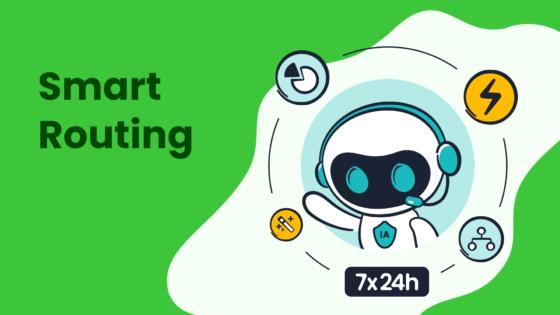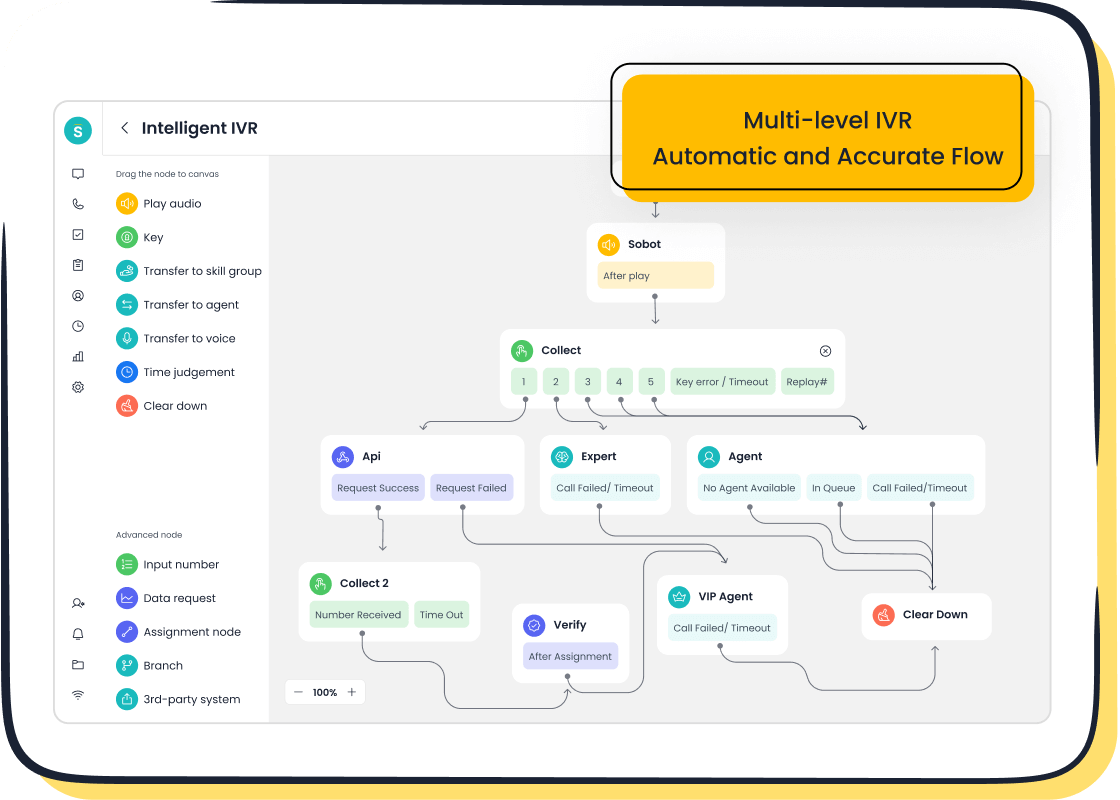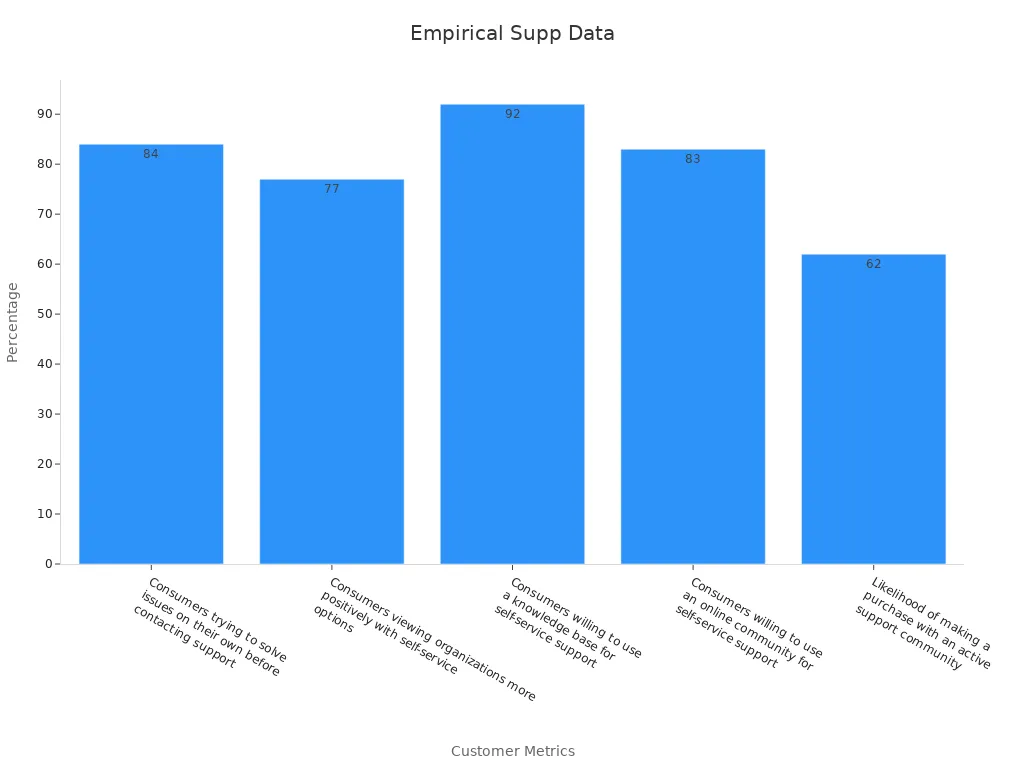How to Create an Omnichannel Cloud Contact Center Strategy

An omnichannel cloud contact center strategy enables you to deliver consistent and personalized interactions across all communication channels. This approach ensures a seamless customer journey, which is critical for boosting customer satisfaction and loyalty. Studies reveal that 89% of customers remain loyal to companies with strong omnichannel engagement, while 95% link their loyalty to excellent customer service experiences.
Sobot, a pioneer in omnichannel solutions, empowers businesses to enhance customer experiences with advanced tools like AI-driven chatbots, unified workspaces, and intelligent voice systems. By adopting such a strategy, your business can improve service efficiency, reduce costs, and build stronger customer relationships.
Understanding Omnichannel Cloud Contact Centers

What Is an Omnichannel Cloud Contact Center?
An omnichannel cloud contact center is a centralized platform that integrates all communication channels, such as phone, email, social media, and live chat, into a seamless system. This allows your agents to switch between channels effortlessly while maintaining a unified view of customer interactions. Unlike traditional systems, this approach ensures that every interaction contributes to a cohesive customer journey. For example, if a customer starts a conversation on social media and continues it via email, your agents can access the entire history without asking the customer to repeat themselves.

Cloud-based contact centers like Sobot's Voice/Call Center take this concept further by offering advanced tools such as intelligent call routing, real-time analytics, and AI-powered voicebots. These features enhance your team's ability to deliver personalized and efficient service, no matter which channel your customers prefer.
Key Features of an Omnichannel Contact Center
Omnichannel contact centers come equipped with features designed to improve both customer and agent experiences. Here are some key functionalities:
- Advanced Contact Routing: Direct inquiries to the right agents based on skills or priorities.
- Unified Workspace: Provide agents with a single interface to manage all customer interactions.
- Real-Time Reporting: Monitor performance and make data-driven decisions.
- Integrated Voice Response (IVR): Enable self-service options and streamline call routing.
- Customer Insights: Use analytics to understand customer behavior and preferences.
- Scalability: Adjust resources to meet fluctuating demands.
Sobot's omnichannel solutions, for instance, unify customer data across channels, allowing your team to deliver consistent and personalized experiences. This not only boosts customer satisfaction but also improves operational efficiency.
How Omnichannel Differs from Multichannel Approaches
The difference between omnichannel and multichannel approaches lies in integration and customer experience. While multichannel contact centers offer multiple communication options, they often lack integration. This means customers may need to repeat their issues when switching channels. In contrast, omnichannel communication ensures a seamless experience by unifying data across all platforms.
| Feature | Multichannel Contact Centers | Omnichannel Contact Centers |
|---|---|---|
| Integration | Channels are not integrated | Channels are integrated |
| Customer Experience | Customers may need to repeat information | Seamless experience without repetition |
| Strategy | Provides multiple options without connection | Unifies data for personalized interactions |
Businesses with strong omnichannel strategies see a 91% higher year-over-year increase in customer retention rates. Additionally, customers engaging across multiple channels spend 10% more than those using a single channel. By adopting an omnichannel cloud contact center, you can meet these expectations and drive better outcomes for your business.
Benefits of Omnichannel Cloud Contact Centers for Businesses
Enhancing Customer Experience with Omnichannel Customer Service
An omnichannel contact center transforms how you interact with customers by delivering seamless and personalized interactions across all channels. Customers no longer need to repeat their issues when switching between platforms like email, social media, or voice calls. This unified approach ensures a consistent customer experience, which is vital for building trust and satisfaction.
For example, 84% of customers attempt to resolve issues independently before contacting support. By integrating self-service options like AI-driven chatbots and knowledge bases, you empower customers to find solutions quickly. Additionally, 77% of customers view businesses more positively when self-service options are available. Sobot’s omnichannel solutions, such as its unified workspace and AI-powered tools, enable you to provide exceptional service while maintaining a human touch.

Improving Operational Efficiency and Reducing Costs
Omnichannel cloud contact centers streamline operations, allowing you to manage customer interactions efficiently. By consolidating communication channels into a single platform, you reduce the time agents spend switching between systems. This boosts productivity by 23%, as reported by organizations using omnichannel solutions.
Cloud-based systems also eliminate the need for expensive hardware and maintenance. Instead, you can scale operations based on demand, converting large upfront costs into predictable operating expenses. Metrics like cost per contact and first contact resolution help you measure efficiency and identify areas for improvement. Sobot’s solutions, such as its intelligent IVR and real-time analytics, further enhance operational efficiency while reducing costs.
Increasing Customer Retention and Brand Loyalty
Exceptional customer experiences foster loyalty and drive retention. Businesses using omnichannel strategies report a 90% higher retention rate compared to single-channel approaches. Personalized interactions, made possible by unified customer data, make customers feel valued and understood.
Omnichannel campaigns also lead to a 494% higher order rate, demonstrating their impact on sales growth. Sobot’s omnichannel platform enables you to deliver consistent and personalized service, ensuring customers remain loyal to your brand. By leveraging tools like AI-driven insights and proactive engagement, you can build lasting relationships with your audience.
Steps to Build an Omnichannel Cloud Contact Center Strategy
Mapping the Customer Journey Across Channels
Mapping the customer journey is the foundation of an effective omnichannel strategy. It helps you understand how customers interact with your business across various communication channels. By visualizing these interactions, you can identify pain points and opportunities to improve the customer experience.
To map the customer journey effectively:
- Identify preferred channels: Analyze customer preferences to determine which communication channels they use most frequently.
- Outline customer personas: Create detailed profiles to understand the needs and behaviors of different customer segments.
- Study interactions: Examine how customers move between channels and pinpoint areas where friction occurs.
For example, Deutsche Telekom used journey mapping to shift its focus toward customer experience, while Chile’s government improved citizen services by identifying gaps in user journeys. These cases highlight the importance of documenting customer journeys to enhance satisfaction and retention.
Sobot’s omnichannel solutions simplify this process by consolidating customer data into a unified workspace. This allows you to track interactions across channels and deliver personalized interactions that meet customer expectations.
Tip: Use analytics tools to monitor customer behavior and refine your journey map regularly. This ensures your strategy evolves alongside customer needs.
Selecting the Right Communication Channels for Your Business
Choosing the right communication channels is critical for delivering effective omnichannel customer service. The channels you select should align with your business goals, customer preferences, and operational capabilities.
When evaluating communication channels:
- Understand your team’s preferences: Ensure your agents are comfortable using the selected platforms.
- Consider the nature of your message: Choose channels based on whether your communication is formal, informal, or urgent.
- Evaluate your budget: Assess the cost-effectiveness of each channel to avoid overspending.
- Gather feedback: Use surveys and analytics to identify which channels customers prefer.
For instance, businesses in retail often prioritize social media and live chat for quick responses, while financial services may rely on voice calls for complex inquiries. Sobot’s cloud-based contact center supports a wide range of communication channels, including voice, email, and social media, ensuring you can manage customer interactions seamlessly.
Note: Start with the channels most relevant to your audience and expand as your strategy matures.
Choosing the Best Omnichannel Software, Featuring Sobot's Voice/Call Center
Selecting the right software is essential for implementing an omnichannel strategy. The software should integrate all communication channels into a single platform, enabling your team to manage customer interactions efficiently.
Sobot’s Voice/Call Center offers a robust solution for businesses seeking to enhance their omnichannel communications. Key features include:
- Intelligent IVR: Customize call routing and enable self-service options.
- Unified Workspace: Provide agents with a centralized interface to handle interactions across channels.
- AI-powered Voicebot: Automate responses and recognize customer intent for faster resolutions.
- Global Number Availability: Support customers worldwide with access to international phone numbers.
These features improve efficiency and ensure a seamless customer journey. For example, Opay, a financial service platform, leveraged Sobot’s omnichannel software to increase customer satisfaction by 30% and reduce costs by 20%. This demonstrates how the right software can transform your customer service operations.
Callout: Look for software with high system uptime and scalability to accommodate growing business needs. Sobot’s 99.99% SLA ensures reliable performance even during peak demand.
Training Teams for Multichannel and Omnichannel Interactions
Training your team is essential for delivering consistent and high-quality customer interactions across all communication channels. Employees must understand how to navigate both multichannel and omnichannel environments to meet customer expectations effectively. A well-trained team ensures that your omnichannel strategy succeeds in creating seamless customer experiences.
Start by educating your team on the differences between multichannel and omnichannel approaches. Multichannel focuses on offering multiple communication channels, while omnichannel integrates these channels to provide a unified customer journey. This distinction helps your team understand the importance of maintaining context and continuity in customer interactions.
To prepare your team:
- Provide role-specific training: Tailor training programs to the unique responsibilities of each role. For example, agents handling voice calls may need to master intelligent IVR systems, while those managing live chat should focus on real-time response techniques.
- Leverage technology: Use tools like Sobot’s unified workspace to familiarize your team with managing interactions across multiple channels. This platform consolidates customer data, enabling agents to deliver personalized service efficiently.
- Simulate real-world scenarios: Conduct role-playing exercises to help agents practice handling complex customer inquiries. This builds confidence and ensures they can adapt to various situations.
A white paper on omnichannel marketing highlights the importance of understanding consumer preferences and ensuring a consistent experience throughout the customer journey. By aligning training with these principles, you empower your team to deliver exceptional service. Additionally, the 'Executing Omnichannel' playbook outlines a four-step process for implementing an omnichannel strategy, emphasizing the need to design processes that align with your brand promise. Incorporating such insights into your training programs ensures your team is well-equipped to handle omnichannel interactions.
Tip: Regularly update training materials to reflect changes in customer behavior and technology. This keeps your team prepared for evolving demands.
Breaking Down Silos Between Departments for Unified Operations
Silos within organizations often hinder the success of an omnichannel cloud contact center. These silos can exist across technology, communication channels, and even customer experience (CX) visions. Breaking them down is crucial for fostering collaboration and ensuring a seamless customer journey.
To unify operations:
- Improve communication and transparency: Encourage open dialogue between departments. Sharing updates and insights helps teams align their efforts toward common goals.
- Adopt collaborative tools: Use a single platform, like Sobot’s omnichannel solution, to bridge gaps between departments. This tool integrates existing systems, enabling teams to access shared customer data and work cohesively.
- Promote a culture of gratitude: Recognize and celebrate contributions from all departments. This builds trust and fosters a positive work environment.
Organizations that address silos through a unified CX transformation strategy see significant improvements in operational efficiency. For example, integrating Sobot’s omnichannel platform allows businesses to connect siloed projects, ensuring that all teams work toward delivering consistent customer experiences. This approach not only enhances collaboration but also reduces redundancies and improves resource allocation.
Callout: Sharing organizational stories can promote knowledge exchange and inspire teams to adopt best practices. This strengthens the overall culture and aligns everyone with the company’s vision.
By breaking down silos and training your team effectively, you create a strong foundation for your omnichannel strategy. These steps ensure that your business delivers seamless and personalized customer interactions, driving satisfaction and loyalty.
Best Practices for Implementing an Omnichannel Cloud Contact Center
Leveraging AI and Automation for Smarter Interactions
AI and automation transform how you manage customer interactions. These technologies streamline processes, reduce response times, and enhance the overall customer experience. For example, Delta Airlines uses AI to predict service issues, achieving a 12% increase in customer satisfaction. Similarly, AT&T implemented AI-powered chatbots, resolving 80% of inquiries without human intervention and cutting operational costs by 25%.
You can use AI to analyze customer data, predict needs, and offer personalized solutions. Automation simplifies repetitive tasks like ticket routing or follow-ups, allowing agents to focus on complex issues. Sobot’s AI-powered Voicebot, for instance, recognizes customer intent and provides instant resolutions, ensuring seamless integration across channels. By adopting these tools, you create smarter workflows and deliver exceptional omnichannel customer service.
Optimizing Workflows with Tools Like Sobot's Unified Workspace
Efficient workflows are essential for delivering consistent service. Tools like Sobot’s Unified Workspace consolidate customer data and interactions into a single platform. This eliminates the need for agents to switch between systems, boosting productivity and reducing errors.
To optimize workflows:
- Use a unified platform for seamless integration of communication channels.
- Automate routine tasks like ticket assignment or call routing.
- Monitor performance metrics to identify bottlenecks and improve processes.
For example, Walmart optimized its supply chain using AI, reducing excess inventory by 30% and improving customer satisfaction by 20%. Similarly, Sobot’s Unified Workspace enhances agent efficiency by providing a centralized interface for managing interactions. This ensures your team can deliver personalized and efficient service across all channels.
Setting Clear SLAs and Performance Metrics
Clear SLAs (Service Level Agreements) and performance metrics set expectations and drive accountability. They ensure consistent service quality and improve customer satisfaction. For instance, SLAs can define response times, resolution times, and system uptime, providing a measurable framework for evaluating performance.
Key SLA metrics include:
- Uptime/availability: Ensures system accessibility during service windows.
- First-call resolution: Measures issues resolved during the initial contact.
- Customer satisfaction: Captures user feedback through surveys.
A well-defined SLA reduces misunderstandings and enhances trust. Sobot’s 99.99% SLA guarantees high system reliability, ensuring uninterrupted service. By setting clear metrics, you can monitor performance, identify areas for improvement, and deliver a superior customer experience.
Continuously Monitoring and Improving Customer Interactions
Monitoring and improving customer interactions is essential for maintaining high service standards. By continuously analyzing performance, you can identify areas for improvement and implement strategies to enhance customer satisfaction. A structured framework for continuous improvement ensures your team stays proactive and responsive to customer needs.
Start by tracking key metrics that provide insights into your service quality. These metrics include:
| Metric | Description |
|---|---|
| Customer Satisfaction Score | Measures customer satisfaction with a service or product. |
| Net Promoter Score | Gauges customer loyalty and likelihood of recommending the service to others. |
| Customer Lifetime Value | Estimates the total revenue a business can expect from a single customer account. |
| Quality Assurance Scores | Evaluates the quality of service provided by customer service agents. |
These metrics help you understand customer behavior and identify trends. For example, a high Net Promoter Score indicates strong customer loyalty, while Quality Assurance Scores highlight areas where agents may need additional training.
To improve interactions, equip your team with tools that enhance their ability to engage proactively. Sobot’s unified workspace consolidates customer data, enabling agents to access interaction histories and provide personalized solutions. This approach reduces response times and ensures consistency across channels.
The continuous improvement model emphasizes refining processes to boost efficiency and quality. For instance, analyzing call data can reveal patterns in customer inquiries, allowing you to adjust workflows or introduce self-service options. Sobot’s AI-powered Voicebot automates repetitive tasks, freeing agents to focus on complex issues. This not only improves operational efficiency but also enhances the overall customer experience.
Tip: Regularly review performance metrics and gather customer feedback to refine your strategy. Small adjustments can lead to significant improvements in satisfaction and loyalty.
By adopting these practices, you create a dynamic system that evolves with customer expectations. Continuous monitoring and improvement ensure your contact center remains a valuable asset for your business.
The Future of Omnichannel Cloud Contact Centers

Emerging Trends in Omnichannel Customer Service
Omnichannel customer service is evolving rapidly, driven by technological advancements and changing customer expectations. Businesses are adopting unified systems to ensure seamless interactions across all communication channels. This shift eliminates gaps in customer experiences and fosters loyalty.
Emerging trends include:
- Advanced AI tools that manage customer data holistically.
- Predictive analytics to anticipate customer needs based on interaction history.
- Enhanced personalization through machine learning, delivering tailored solutions at scale.
- Unified commerce systems integrating sales channels for a seamless shopping experience.
- Mobile-optimized platforms to cater to the growing number of mobile users.
These trends highlight the importance of staying ahead in customer service innovation. Sobot’s omnichannel solutions, such as its AI-powered Voicebot and unified workspace, align with these developments, enabling businesses to deliver personalized and efficient service across all platforms.
The Role of AI and Predictive Analytics in Customer Support
Artificial intelligence and predictive analytics are transforming customer support. AI leverages big data to create detailed customer profiles, offering personalized recommendations and targeted solutions. Predictive analytics uses historical data to forecast customer needs, enabling proactive engagement.
AI algorithms analyze purchase history, browsing behavior, and social media interactions to deliver tailored experiences. Chatbots powered by AI provide instant responses, reducing wait times and freeing agents to focus on complex issues.
Sobot’s AI-driven tools, including its Voicebot and real-time analytics, empower businesses to harness these technologies effectively. By integrating predictive analytics, you can anticipate customer inquiries and resolve issues before they escalate, enhancing satisfaction and loyalty.
How Businesses Can Stay Ahead with Solutions Like Sobot's Omnichannel Platform
To maintain a competitive edge, businesses must adopt innovative solutions that unify customer interactions. Omnichannel platforms like Sobot’s provide a seamless experience across all touchpoints, ensuring consistent service quality.
| Key Takeaways | Evidence |
|---|---|
| Customer acquisition and retention | Omnichannel marketing attracts new customers and retains existing ones through consistent experiences. |
| Revenue growth | Connected experiences increase sales by up to 10% and reduce returns by 30%. |
| Competitive differentiation | Unified systems set businesses apart, establishing a strong market presence. |
Sobot’s platform integrates AI-driven tools, enabling businesses to deliver personalized service while optimizing operations. By leveraging features like intelligent IVR and unified workspaces, you can enhance customer satisfaction and drive growth.
Adopting an omnichannel cloud contact center strategy is essential for delivering seamless customer experiences. This approach enhances customer satisfaction, improves retention, and drives business growth. Start by leveraging proven solutions like Sobot’s platform, which reduces waiting times by 35% and generates 70% of business from upgrades. These tools unify communication channels, streamline operations, and empower your team to deliver personalized service. As customer expectations evolve, embracing AI and predictive analytics will keep your business ahead. By acting now, you position your brand for long-term success in a competitive market.
FAQ
What is the difference between omnichannel and multichannel contact centers?
Omnichannel contact centers integrate all communication channels into one platform, ensuring seamless customer experiences. Multichannel systems offer multiple channels but lack integration, requiring customers to repeat information. For example, Sobot’s omnichannel solution unifies data across channels, enabling agents to deliver personalized service without interruptions.
How does an omnichannel strategy improve customer satisfaction?
An omnichannel strategy ensures consistent and personalized interactions across all channels. Customers can switch between platforms without repeating themselves. For instance, Sobot’s unified workspace consolidates customer data, allowing agents to resolve issues faster. Businesses using omnichannel strategies report a 90% higher retention rate.
What industries benefit most from omnichannel cloud contact centers?
Industries like retail, financial services, gaming, and education benefit significantly. For example, Opay, a financial service platform, used Sobot’s omnichannel solution to increase customer satisfaction by 30% and reduce costs by 20%. This demonstrates the versatility of omnichannel systems across sectors.
How does Sobot ensure system reliability?
Sobot guarantees 99.99% system uptime, ensuring uninterrupted service. Its global network spans 110 points of presence in 93 cities, providing stable and scalable solutions. This reliability supports businesses during peak demand, ensuring consistent customer experiences.
Can small businesses afford omnichannel solutions?
Yes, small businesses can adopt cost-effective omnichannel solutions like Sobot’s SaaS rental model. This eliminates the need for expensive hardware. Features like AI-powered chatbots and intelligent IVR reduce operational costs while improving efficiency, making it accessible for businesses of all sizes.
Tip: Start with essential channels and expand as your business grows. Sobot’s scalable solutions adapt to your needs.
See Also
A Comprehensive Guide to Omnichannel Contact Center Implementation
Essential Insights on Omnichannel Call Center Software Solutions
Best Reviewed Cloud Contact Center Services for 2024
Discovering Leading Cloud Contact Centers for 2025
Comprehensive Reviews of Leading Contact Center Solutions 2024
